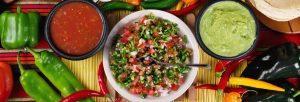A distinctive feature of Mexican cuisine
Is the seductive aromas of spices added to food, which speaks of the richness of taste. Mexico is lucky to have both an abundance of first-class cooking products and people who know how to find real pleasure in food. Mexicans, using food in every possible way, have created a fascinating encyclopedia of dishes in a wide variety of flavors. However, it would be a mistake to think that all Mexican dishes are spicy and heavily spiced. Some, such as vegetable soup, have a subtle, moderate flavor that does not interfere with the natural flavors of high-quality ingredients. If spices are added, then with a sense of proportion, so that the taste is soft and harmonious. Not all dishes contain chili (hot peppers), and even those that do have it can be cooked spicy or milder to your liking.
The culinary style that today is called Mexican has evolved over many centuries.
It is a kind of fusion of various culinary traditions. This style has its roots in the ancient Aztec and Mayan civilizations. It is based on a rich selection of products available to these peoples: corn (maize), avocados, fresh and dried beans, sweet and regular potatoes, tomatoes, chilli peppers, pumpkin, duck and turkey meat, chocolate, as well as many types of fish that live in coastal waters of Mexico.
In the middle of the last century, the influence of French cuisine was added, as evidenced by a large selection of various, very tasty buns, cakes and puddings, which are still a success.
Since Mexico shares a border with the United States, it is not surprising that there is now a tangible influence of American cuisine. At the same time, the United States also contributed to the spread of Mexican cuisine around the world, although, it should be noted that “TechMech” (Tex-Mex restaurants) in Mexico itself is more difficult to find than outside it.
The most popular dish of Mexican national cuisine is tacos – corn tortilla stuffed, fried on coals. The filling depends on the taste and imagination of the cook – meat, vegetables, fruits – and is placed on top. Establishments that eat “tacos” are called taquerias in Mexico City. Taquerias flooded all of Mexico City, successfully competing with McDonald’s, pizzerias and Chinese restaurants.
Among the many taquerias in Mexico City, there is one that is especially revered by the public – its visitors, in addition to ordinary food, also receive spiritual food. It is located on Chola Street, a stone’s throw from the representative office of Aeroflot. This is a real museum. In the cafe, modestly referred to by the people as the Museum of Tacos, along with products of gastronomic art (tacos), the visitor will be able to enjoy other masterpieces – from the field of painting, sculpture, music, photography. In the hall decorated in this way, pyramids of fiery corn cakes seasoned with red and green sauce on the tables are in perfect harmony with the paintings and prints on the walls.
Mexican cuisine ranges from easy-to-make tacos and tostados for a quick snack, to festive dishes like mole poblanos or mouth-watering beans and other vegetable dishes that make you realize that vegetarian food can also bring joy.
The most popular cheese in Mexico is the easy-to-crumble, salty-tasting queso fresco. Another common type of cheese is “Queso de Chihuahua”. Chili peppers are the hallmark of Mexican cuisine, they are used both raw and processed to give the dish a specific flavor and spiciness. Another “calling card” is chayote. Chayote is a fruit weighing from 180 to 360 g, outwardly similar to a ribbed pear, with a light green rather thick skin and crisp white pulp with a delicate taste. Chayote is eaten baked, stewed, boiled in casseroles, and sometimes raw in salads. You can peel them both before and after cooking. The seeds of the young chayote are also edible.
